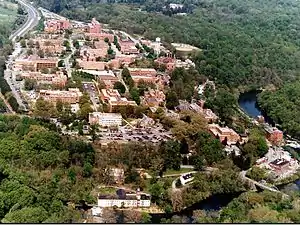DuPont Experimental Station
The DuPont Experimental Station is the largest research and development facility of DuPont.[1] Located on the banks of the Brandywine Creek in Wilmington, Delaware, it is home to some of the most important discoveries of the modern chemical industry.[2][3]

Overview
The Experimental Station marked its 100th anniversary in 2003. It was founded as an effort to move the DuPont Company from gunpowder and explosives into the new age of chemistry.[1] The site overlooks the original powder mills upon which the company was founded - now Hagley Museum and Library, a nonprofit educational institution documenting the history of DuPont business and technology. The Experimental Station is east from Hagley Museum and west-southwest from the Alfred I. duPont Hospital for Children.
As one of the first industrial research laboratories in the United States, the 150-acre (0.61 km2) campus-style Experimental Station in Wilmington, Delaware, serves as the primary research and development facility for DuPont. It is home to DuPont's Central Research and most other business units of DuPont are also represented on site. The Experimental Station is the birthplace of many of the innovative materials and products developed by DuPont since 1903, including:
- Neoprene - the world's first synthetic rubber;
- Nylon polyamide for fibers and engineering polymers for machine parts, gears, electrical systems and even automobile air intake manifolds;[4]
- Tyvek nonwovens for housewrap, envelopes, medical packaging, environmental protection and currency;
- Kevlar fiber for body armor and automobile tire reinforcement;[5][6]
- Mylar polyester film for packaging material and balloons;[7]
- Corian solid surface materials for countertops, flooring and art;[8]
- Butacite polyvinyl butyral, the safety interlayer in laminated glass;[9] and
- Nomex fiber for firefighting equipment and other thermal protection applications.
- Simple Crown ethers were invented by Charles J. Pedersen in 1967, for which he won the Nobel Prize in 1987. There is a plaque at the Experimental Station marking the location of the lab where his work took place.
For a more complete description of the inventions of the scientists and engineers of the Experimental Station, see the List of DuPont Experimental Station Inventions.
Today nearly 2,000 scientists and researchers - including roughly 600 with Ph.D.s - pursue new opportunities for a broad range of global markets including agriculture and nutrition, electronics, safety and protection, coatings and performance materials.[10] There are over 50 buildings encompassing 250,000 square meters of research space. This centralized facility allows collaborations to enhance scientific discovery. More recent successes include Suva refrigerants, the BAX food safety systems and Sorona polyester.
Research and development now under way includes nanotechnology, emerging video display technologies, fuel cells, and biomaterials produced from renewable resources such as corn. These developments could lead to foods that help prevent diseases and brittle bones, "smart" materials that can adjust performance on their own, microorganisms that produce biodegradable products and innovative materials for personal protection.
On the morning of January 24, 2007, President George W. Bush became the first president to visit the Experimental Station.[11] He saw examples of how DuPont is putting science to work to provide products for agricultural energy crops, feedstock processing and advanced biofuels such as ethanol and bio-butanol. He also viewed other alternative energy sources and technologies dealing with energy conservation. These are all part of DuPont’s sustainable growth mission.
References
- See David A. Hounshell and John Kenly Smith, Jr., “Science and Corporate Strategy — DuPont R&D 1902–1980,” Cambridge University Press, 1988, as a general historical reference about DuPont that includes much information about the Experimental Station.
- Adrian Kinnane, “DuPont: From the Banks of the Brandywine to Miracles of Science,” Johns Hopkins University Press, February 26, 2002 ISBN 0-8018-7059-3.
- For more early history and an early photograph of the Experimental Station, see "Archived copy". Archived from the original on 2007-04-02. Retrieved 2007-04-09.CS1 maint: archived copy as title (link)
- History of Nylon Archived 2008-06-21 at the Wayback Machine US Patent 2,130,523 'Linear polyamides suitable for spinning into strong pliable fibers', U.S. Patent 2,130,947 'Diamine dicarboxylic acid salt' issued and U.S. Patent 2,130,948 'Synthetic fibers', all issued 20 September 1938
- D. Tanner, J. A. Fitzgerald, B. R. Phillips, "The Kevlar Story - an Advanced Materials Case Study," Angewandte Chemie International Edition in English 28(5), 649 - 654 (1989)
- E. E. Magat, "Fibres from Extended Chain Aromatic Polyamides, New Fibres and Their Composites," Philosophical Transactions of the Royal Society of London Series A, 294(1411) 463-472 (1980)
- 1952: Mylar Archived April 11, 2007, at the Wayback Machine
- For a more thorough description of Corian surfaces, see http://www2.dupont.com/Surfaces/en_US/products/corian/index.html
- For some unique applications of DuPont’s safety glass see http://news.bbc.co.uk/1/hi/world/americas/6469941.stm for information about the Grand Canyon Skywalk and "Archived copy". Archived from the original on 2015-02-02. Retrieved 2016-02-09.CS1 maint: archived copy as title (link) for a view of the glass stairway in the Apple store in New York.
- DuPont.com: Experimental Station
- For more about Bush's visit and his speech on energy, see https://georgewbush-whitehouse.archives.gov/news/releases/2007/01/20070124-5.html